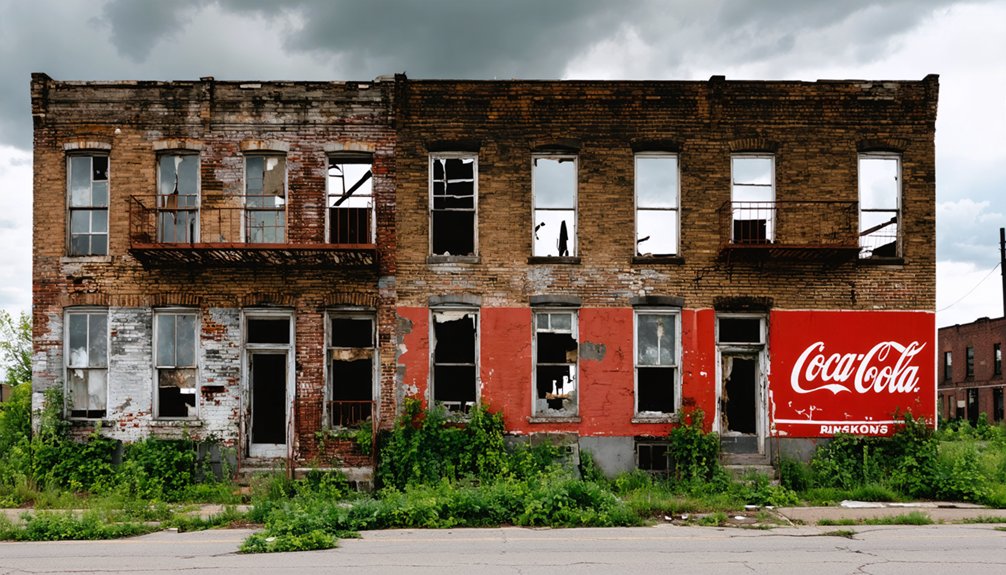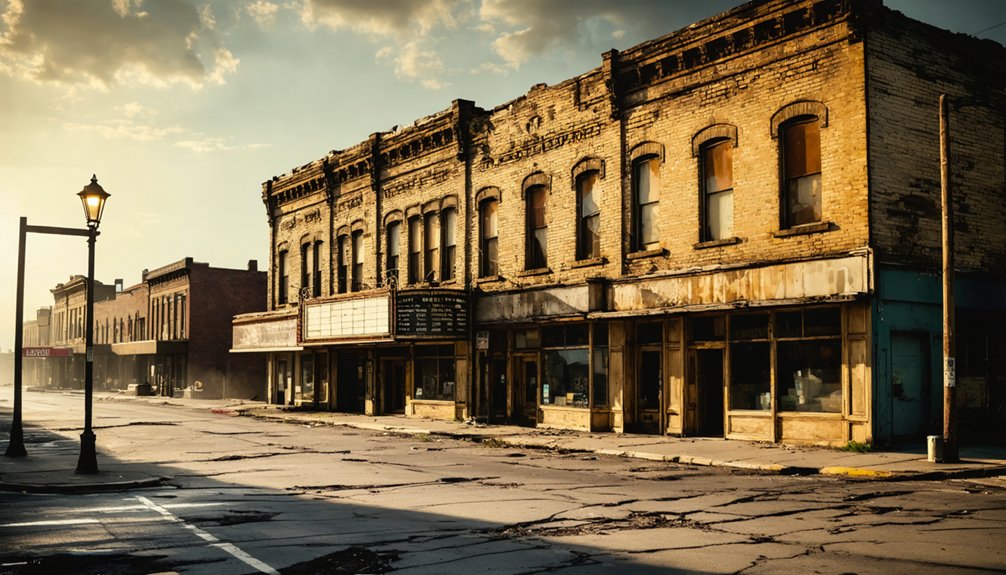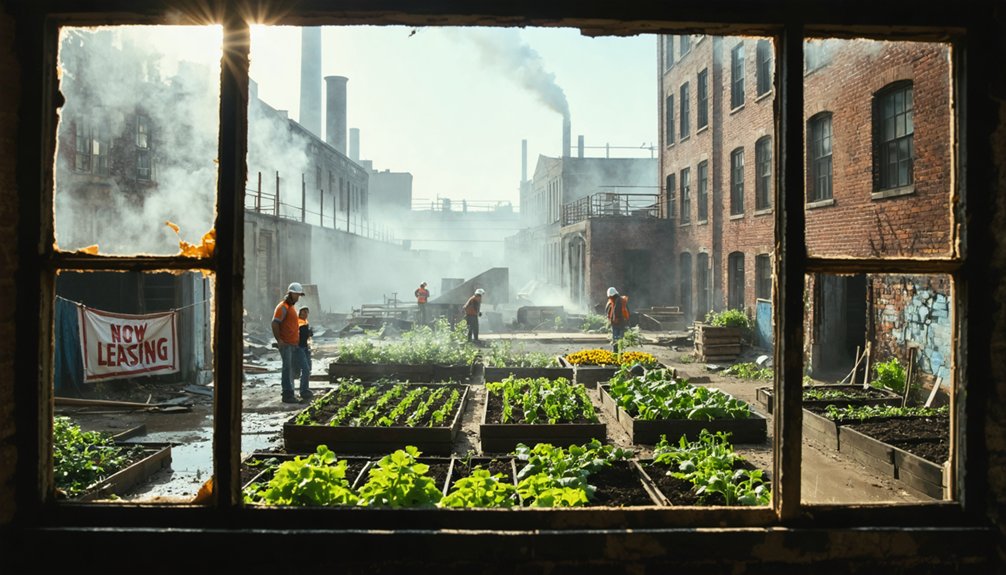America’s Rust Belt features five dramatically shrinking communities: Detroit (65% population loss since 1950), Gary (58% decline since 1960), Youngstown (70% decrease from peak), Buffalo (44% reduction 1970-2006), and Flint (20% drop since 2014’s water crisis). These former manufacturing powerhouses face similar challenges—abandoned infrastructure, poverty, and unemployment—yet each shows unique signs of potential revival. Recent population increases in Detroit and Flint suggest the Rust Belt’s decline isn’t necessarily their final chapter.
Key Takeaways
- Detroit has experienced a 65% population loss since 1950 but shows signs of revival with 1.1% growth since 2020.
- Gary’s population plummeted from 178,000 to 75,000 as steel jobs decreased from 30,000 to 8,000.
- Youngstown lost nearly 70% of its peak population following manufacturing decline and GM’s elimination of 2,800 jobs.
- Buffalo’s population fell 44% between 1970-2006, though recent growth in manufacturing jobs outpaces other Rust Belt cities.
- Flint faced devastating population loss following its water crisis but recorded its first growth in 25 years with 76 new residents in 2024.
Detroit, Michigan: A Fallen Motor City Rebuilding Its Engine
Once America’s industrial powerhouse and the fourth-largest city in the nation, Detroit has experienced one of the most dramatic population declines in U.S. history, plummeting from 1.85 million residents in 1950 to just 639,111 by 2020—a staggering 65% loss.
Yet, recent data signals a potential revival. For two consecutive years, Detroit has gained population, reaching 645,705 residents in 2024—growing at 1.1%, outpacing both Michigan and national averages. The city has added a total of 12,487 residents between 2021 and 2024.
After decades of decline, Detroit’s population grows for the second year, outpacing state and national trends.
This economic revitalization, though modest, marks a significant shift for the former “Motor City” that suffered decades of deindustrialization, housing abandonment, and middle-class exodus. As the county seat of Wayne County, Detroit continues to serve as an important administrative center despite its economic challenges.
Despite continuing challenges of poverty and urban blight, targeted demolition programs paired with new housing developments in neighborhoods like Downtown, Corktown, and Midtown are gradually rewriting Detroit’s narrative from decline to rebirth.
Gary, Indiana: The Steel Giant’s Empty Streets and Silent Mills
While Detroit’s population has shown early signs of revival, Gary, Indiana presents a starker portrait of industrial collapse with fewer indications of recovery. Founded as a U.S. Steel company town in 1906, Gary’s industrial legacy is inseparable from its identity and decline.
The city’s population decline tells a sobering story:
- Population plummeted from 178,000 in 1960 to just 75,000 by 2020
- Steel employment fell from 30,000 during peak years to roughly 8,000
- Over one-third of buildings now stand blighted, with nearly half of lots empty
With an 85% African American population, 28% poverty rate, and 19% unemployment, Gary exemplifies the harsh reality of America’s deindustrialization. The city’s landscape resembles a ghost town with crumbling houses and overgrown lots where families once thrived. The dramatic transformation of the local economy is further evidenced by health care surpassing steel mills as the largest employer in the region.
Unlike other Rust Belt cities, revitalization efforts remain nascent, though sustainability projects and economic diversification initiatives offer glimmers of potential.
Youngstown, Ohio: From Steel Valley to Opportunity Desert
Situated between Pittsburgh and Cleveland in the heart of America’s industrial corridor, Youngstown, Ohio represents one of the most dramatic examples of Rust Belt decline in the United States.
Since 2000, manufacturing jobs plummeted by 22%, with GM alone cutting 2,800 positions, devastating the local economy.
The city’s population has shrunk nearly 70% from its peak, bringing increased poverty, crime, and housing market collapse.
Unlike Pittsburgh’s successful shift to tech and healthcare, Youngstown’s economic revitalization efforts have yielded limited results.
Despite attempts to transform from “Steel Valley” to “Tech Belt” through tax breaks and small business development, job creation remains stunted.
The city continues prioritizing infrastructure downsizing while pursuing diversification into education and health services—a challenging path forward for a community that once flourished on America’s industrial might.
The opioid crisis has further devastated Youngstown, with local rehabilitation centers overwhelmed by the addiction epidemic that has claimed numerous lives in the community.
Recent initiatives have focused on transforming abandoned industrial sites through strategic investments to create new economic opportunities.
Buffalo, New York: Weathering Economic Storms on Lake Erie
Located on the eastern shores of Lake Erie, Buffalo, New York has experienced a profound transformation from its days as a manufacturing powerhouse. The city’s population plummeted by 44% between 1970-2006, while median household income fell 23% in real terms—emblematic of Rust Belt decline driven by industrial collapse.
Despite these challenges, Buffalo’s story isn’t simply one of decay. Recent economic diversification efforts have yielded:
- A net gain of 5,200 manufacturing jobs, outpacing other Rust Belt cities
- Growth in non-manufacturing private-sector employment
- State investments in high-tech manufacturing sectors
The manufacturing wages in Buffalo-Niagara Falls remain 41% higher than service sector jobs, providing crucial economic support for the region’s workforce. The city’s industrial growth was historically facilitated by the opening of the Erie Canal in 1825, which connected the Great Lakes to the Atlantic seaboard.
Urban revitalization remains uneven, with some neighborhoods experiencing educational attainment improvements and rising home values, while others face concentrated poverty and blight.
Buffalo’s recovery represents America’s industrial heartland struggling to reinvent itself while honoring its manufacturing heritage.
Flint, Michigan: Beyond the Water Crisis
Once a thriving center of American automobile manufacturing, Flint, Michigan has become synonymous with one of the nation’s most severe public health disasters. The 2014 water source switch exposed 99,000 residents to lead contamination, creating lasting health consequences particularly for children.
Despite replacing 11,000 lead pipes and meeting federal water standards for seven years, nearly half the population lives in poverty while the city’s population has fallen 20% since the crisis began.
The technical fixes mask a deeper crisis—crushing poverty and exodus from a city forever changed.
You’ll find a stark example of environmental racism here, where a largely Black community bore the brunt of governmental neglect.
Yet community resilience emerges through organizations like the Flint Trust Community Alliance advocating for justice. When former Governor Rick Snyder and eight other officials were charged with 34 felony counts related to the crisis in 2021, it represented a rare attempt at government accountability. Recent data shows a slight population increase of 76 residents in 2024, marking the first growth in 25 years.
Economic revitalization remains challenging with fewer residents shouldering infrastructure costs and lingering distrust in government—many still refuse to drink the water despite official assurances.
Frequently Asked Questions
How Have Religious Institutions Responded to Rust Belt Population Decline?
You’ve seen religious institutions merge parishes, close buildings, develop faith-based outreach programs, and form community partnerships while repurposing vacant churches into social service centers that address neighborhood needs despite dwindling resources.
What Role Do Arts and Culture Play in Rust Belt Revitalization?
Arts drive Rust Belt revitalization by generating economic growth—like Milwaukee’s $300 million impact. You’ll see public art installations and cultural festivals creating vibrant neighborhoods that attract creative talent while preserving cultural identity.
How Has the Opioid Epidemic Specifically Impacted Rust Belt Communities?
You’ll see addiction recovery strained by limited mental health services in Rust Belt towns where economic consequences multiply. High unemployment correlates with 4% increases in opioid deaths, devastating community support systems.
What Transportation Infrastructure Changes Followed Industrial Collapse?
You’ll find public transit systems deteriorated as tax bases collapsed. Freight rail networks declined by 67% while highways enabled manufacturing relocation. Legacy transportation infrastructure was abandoned, creating economic isolation for remaining residents.
How Do Rust Belt Political Voting Patterns Reflect Economic Transformation?
You’ll see economic polarization dividing Rust Belt voting patterns—revitalized urban areas vote Democratic while struggling rural communities favor Republicans. This reflects urban migration’s impact, as knowledge-economy cities thrive while factory towns decline.
References
- https://www.youtube.com/watch?v=g00kMsxdpJ8
- https://www.britannica.com/place/Rust-Belt
- https://en.wikipedia.org/wiki/Rust_Belt
- https://www.indire.net/Articles/V8P041-071Tamiggi579.pdf
- https://www.nber.org/digest/202404/global-evidence-decline-and-recovery-rust-belt-cities
- https://en.wikipedia.org/?title=Rust_belt
- https://worldpopulationreview.com/state-rankings/rust-belt-states
- https://www.youtube.com/watch?v=qsyO6tX7LXM
- https://research.upjohn.org/cgi/viewcontent.cgi?params=/context/up_press/article/1242/&path_info=up14wbrttr_2.pdf
- https://www.indystar.com/story/opinion/columnists/2025/03/31/rust-belt-decline-midwest-education/82614743007/



